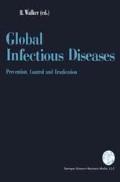Abstract
There are seven filarial parasites affecting over 100,000,000 individuals worldwide (Table 1) (1) . Despite these impressive statistics as recently as 15 years ago, filariasis was still considered to be a “primitive” discipline. The initiation of the UNDP/World Bank/WHO Special Programme in Tropical Disease Research (TDR) has highlighted the importance of filariases, and advances in immunology have led to an increased awareness of many issues of great practical significance. While the prospects for further advances are promising, there still remain a number of significant hindrances. From a positive perspective, these will become challenges for future work. The purposes of this review are to summarize our understanding of the filariases, to identify why we have not progressed further, and to suggest a direction for future research on filarial infections and disease.
Access this chapter
Tax calculation will be finalised at checkout
Purchases are for personal use only
Preview
Unable to display preview. Download preview PDF.
References
WHO (1984) Filariasis-Report of the Fourth Expert Committee, Technical Report Series No. 702. Geneva, World Health Organization
Sasa M (1976) Human filariasis. Baltimore, University Park Press
WHO (1987) Expert Committee on Onchocerciasis — Third Report, Technical Report Series No. 752. Geneva: World Health Organization
Ottesen EA (1990) The filariases and tropical pulmonary eosinophilia. In: Warren KS, Mahmoud AAF (eds) Tropical and geographical medicine. New York, McGraw-Hill, pp 407–428
Dreyer G, Ottesen EA, Galdino E, Andrade L, Rocha A, Medeiros Z, Moura I, Casimiro I, Beliz F, Coutinho A (1992) Renal abnormalities in microfilaremic patients with bancroftian filariasis. Am J Trop Med Hyg (in press)
Nutman TB, Miller KD, Mulligan M, Ottesen EA (1986) Loa loa infection in temporary residents of endemic regions: recognition of a hyperresponsive syndrome with characteristic clinical manifestations. J Infect Dis 154: 10–18
Ottesen EA (1989) Filariasis now. Am J Trop Med Hyg 41: 9–17
Ottesen EA (1980) Immunopathology of lymphatic filariasis in man. Springer Semin Immunopathol 2: 373–385
Ottesen EA, Skvaril F, Tripathy SP, Poindexter RW, Hussain R (1985) Prominence of IgG4 in the IgG antibody response to human filariasis. J Immunol 134: 2707–2712
Suswillo RR, Doenhoff MJ, Denham DA (1981) Successful development of Brugia pahangi in T-cell deprived CBA mice. Acta Trop 1981 38: 305–308
Vincent AL, Vickery AC, Lotz MJ, Desai U (1984) The lymphatic pathology of Brugia paahangi in nude (athymic) and thymic mice C3H/HeN. J Parasitol 70: 48–56
Vickery AC, Albertine KH, Nayar JK, Kwa BH (1991) Histopathology of Brugia malayi infected nude mice after immune-reconstitution. Acta Trop 49: 45–55
Philipp M, Davis TB, Storey N, Carlow CKS (1988) Immunity in filariasis: perspectives for vaccine development. Ann Rev Microbiol 42: 685–716
Ward DJ, Nutman TB, Zea-Flores G, Portocarrero C, Lujan A, Ottesen EA (1988) Onchocerciasis and immunity in humans: enhanced T cell responsiveness to parasite antigen in putatively immune individuals. J Infect Dis 157: 536–543
Freediman DO, Nutman TB, Ottesen EA (1989) Protective immunity in bancroftian filariasis. Selective recognition of a 43-kD larval stage antigen by infection-free individuals in an endemic area. J Clin Invest 83: 14–22
Weil GJ (1990) Parasite antigenemia in lymphatic filariasis. Exp Parasitol 71 : 353–356
Forsyth KP, Spark R, Kazura J, Brown GV, Peters P, Heywood P, Dissanayake S, Mitchell GF (1985) A monoclonal antibody-based immunoradiometric assay for detection of circulating antigen in bancroftian filariasis. J Inmunol 5134: 1172–1177
More SJ, Copeman DB (1990) A highly specific and sensitive monoclonal antibody-based ELISA for the detection of circulating antigen in bancroftian filariasis. Trop Med Parasitol 41: 403–406
Chandrashekar R, Ogunrinade AF, Alvarez RM, Kale OO, Weil GJ (1990) Circulating immune complex-associated parasite antigens in human onchocerciasis. J Infect Dis 162: 1159–1164
Lal RB, Ottesen EA (1988) Enhanced diagnostic specificity in human filariasis by IgG4 antibody assessment. J Infect Dis 158: 1034–1037
Kwan-Lim G-E, Forsyth KP, Maizels RM (1990) Filarial-specific IgG4 response correlates with active Wuchereria bancrofti infection. J Immunol 145: 4298–4305
Ottesen EA (1987) Description, mechanisms and control of reactions to treatment in the human filariases. Ciba Fndn Symp 127: 265–283
Remme J, De Sole G, Dadzie KY, Alley ES, Baker RHA, Habbema DJF, Plaisier AP, van Oort-Marssen GJ, Samba EM (1990) Large scale ivermectin distribution and its epidemiological consequences. Acta Leidensia 59: 177–192
Ottesen EA (1985) Efficacy of diethylcarbamazine in eradicating infection with lymphatic-dwelling filariae in humans. Rev Infect Dis 7: 341–356
Chakravertty RK, Srivastav VK, Srivastava SP, Chand P, Rao CK (1987) Prophylactic effect of diethylcarbamazine on Wuchereria bancrofti filariasis. J Commun Dis 19: 128–135
Nutman TB, Miller KD, Mulligan M, Reinhardt GN, Currie BJ, Steel C, Ottesen EA (1988) Diethylcarbamazine prophylaxis for human loiasis. Results of a double-blind study. N Engl J Med 319: 752–756
Dull HB (1990) Mectizan donation and the Mectizan expert committee. Acta Leidensia, 1990 59: 399–404
Author information
Authors and Affiliations
Editor information
Editors and Affiliations
Rights and permissions
Copyright information
© 1992 Springer Science+Business Media New York
About this chapter
Cite this chapter
Ottesen, E.A. (1992). Filariasis: Present Status and Future Challenges. In: Walker, D.H. (eds) Global Infectious Diseases. Springer, Vienna. https://doi.org/10.1007/978-3-7091-3449-8_10
Download citation
DOI: https://doi.org/10.1007/978-3-7091-3449-8_10
Publisher Name: Springer, Vienna
Print ISBN: 978-3-211-82329-3
Online ISBN: 978-3-7091-3449-8
eBook Packages: Springer Book Archive

